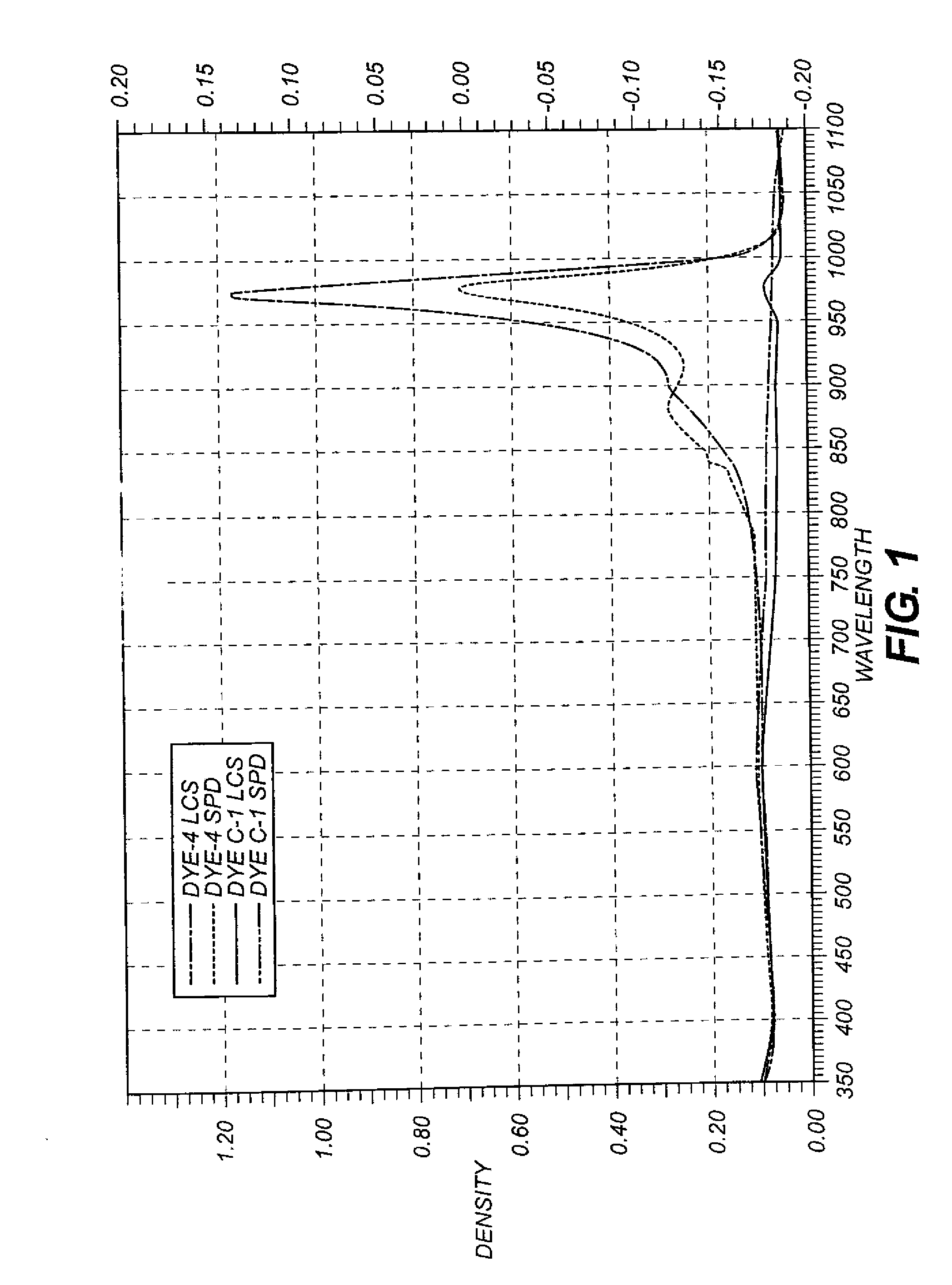Infrared dye for silver halide-based photographic elements
a technology of infrared dyes and photographic elements, applied in multicolor photographic processing, photosensitive materials, instruments, etc., can solve the problems of affecting the development of colloidal metallic silver, reducing the amount of imaging silver (silver halide), and high levels of undesirable colloidal metallic silver, etc., to achieve low visible absorbance, low silver, and high ir
- Summary
- Abstract
- Description
- Claims
- Application Information
AI Technical Summary
Benefits of technology
Problems solved by technology
Method used
Image
Examples
example 1
Solution Spectra
[0145]0.5 g of Dye-1 was dissolved in 5 ml of methanol and its absorbance was measured in solution using a Perkin Elmer UV-Vis spectrophotometer. The wavelength of maximum absorption is reported in Table I as Lmax MeOH. 1.0 g of this solution was diluted with 1.0 g of distilled water to allow the dye to form a J-aggregate. The absorbance of this solution was also measured as described above and the wavelength of maximum absorption of the J-aggregate peak is reported in Table I as Lmax H2O.
[0146]A solid particle dispersion of Dye-1 was made by adding 2 g of dye and 3 g of a 10% solution of surfactant 10G (Dixie) to 20 g of distilled water. This mixture was added to a 4 oz glass jar along with 60 ml of 1.8 mm zirconium oxide beads and placed on a roller mill at a speed of 70 ft / min for 7 days. After milling, the slurry was passed through a fine metal screen and then rinsed with distilled water to separate the dye slurry from the beads to form a final dispersion of 5% d...
example 2
Dispersion Spectra
[0149]Liquid Crystalline Suspension (LCS) Preparation: 1.0 g of Dye-4, 0.2 g of 5.0% solution of Promexal X50 biocide (Zeneca), and 0.02 g of Lumulse 42-OK antifoamant (Lambent) was added to 98.78 g of distilled water in a 250 ml glass beaker and was stirred with a 4 cm Cowels mixer at 1100 rpm for 15 min followed by a Silverson mixer at 5000 rpm for 30 min at room temperature. A microscopic examination using crossed polarizing filters at 100× magnification revealed a coarse, grainy appearance with large domains of birefringence indicating that the dye was present in the liquid crystalline state. No large crystals of dye greater then 1 micron were evident. 1.0 g of comparison dye C-2 was subjected to the same procedure described above. In this case, microscopic examination showed no indication of liquid crystals and the mixture was loaded with many large (10-50 microns) crystals of dye.[0150]Solid Particle Dispersion (SPD) Preparation: 1.0 g of Dye-4 and 1.5 g of a...
example 3
IR Dyes in Multilayer Photographic Format
[0159]Multilayer films demonstrating the principles of this invention were produced by coating the following layers on a cellulose triacetate film support (coverage are in grams per meter squared, emulsion sizes as determined by the disc centrifuge method and are reported in diameter×thickness in micrometers). Surfactants, coating aids, emulsion addenda (including 4-hydroxy-6-methyl-1,3,3a,7-tetraazaindene), sequestrants, thickeners, lubricants and tinting dyes were added to the appropriate layers as is common in the art. Couplers and other non-water soluble materials were added as conventional oil-in-water dispersions as known in the art
PUM
| Property | Measurement | Unit |
|---|---|---|
| weight ratio | aaaaa | aaaaa |
| weight ratio | aaaaa | aaaaa |
| RI | aaaaa | aaaaa |
Abstract
Description
Claims
Application Information
 Login to View More
Login to View More - R&D
- Intellectual Property
- Life Sciences
- Materials
- Tech Scout
- Unparalleled Data Quality
- Higher Quality Content
- 60% Fewer Hallucinations
Browse by: Latest US Patents, China's latest patents, Technical Efficacy Thesaurus, Application Domain, Technology Topic, Popular Technical Reports.
© 2025 PatSnap. All rights reserved.Legal|Privacy policy|Modern Slavery Act Transparency Statement|Sitemap|About US| Contact US: help@patsnap.com



